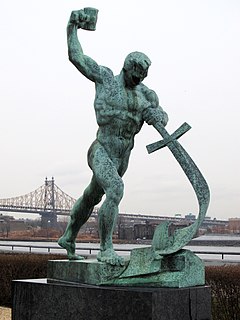Related Research Articles

Nuclear disarmament is the act of reducing or eliminating nuclear weapons. It can also be the end state of a nuclear-weapons-free world, in which nuclear weapons are completely eliminated. The term denuclearization is also used to describe the process leading to complete nuclear disarmament.

Disarmament is the act of reducing, limiting, or abolishing weapons. Disarmament generally refers to a country's military or specific type of weaponry. Disarmament is often taken to mean total elimination of weapons of mass destruction, such as nuclear arms. General and Complete Disarmament was defined by the United Nations General Assembly as the elimination of all WMD, coupled with the “balanced reduction of armed forces and conventional armaments, based on the principle of undiminished security of the parties with a view to promoting or enhancing stability at a lower military level, taking into account the need of all States to protect their security.”
The War Resisters League (WRL) is the oldest secular pacifist organization in the United States.
The Fellowship of Reconciliation is the name used by a number of religious nonviolent organizations, particularly in English-speaking countries. They are linked by affiliation to the International Fellowship of Reconciliation (IFOR).
The International Fellowship of Reconciliation (IFOR) is a non-governmental organization founded in 1914 in response to the horrors of war in Europe. Today IFOR counts 72 branches, groups and affiliates in 48 countries on all continents. IFOR members promote nonviolence, human rights and reconciliation through public education efforts, training programs and campaigns. The IFOR International Secretariat in Alkmaar, Netherlands facilitates communication among IFOR members, links branches to capacity building resources, provides training in gender-sensitive nonviolence through the Women Peacemakers Program, and helps coordinate international campaigns, delegations and urgent actions. IFOR has ECOSOC status at the United Nations.

The World Peace Council (WPC) is an international organization that advocates universal disarmament, sovereignty and independence and peaceful co-existence, and campaigns against imperialism, weapons of mass destruction and all forms of discrimination. It was founded in 1950, emerging from the policy of the Communist Party of the Soviet Union to promote peace campaigns around the world in order to oppose "warmongering" by the United States. Throughout the Cold War, it was largely funded and controlled by the Soviet Union, and refrained from criticizing or even defended the Soviet Union's involvement in numerous conflicts. These factors led to the decline of its influence over the peace movement in non-Communist countries. Its first president was the French physicist and activist Frédéric Joliot-Curie. It was based in Helsinki, Finland from 1968 to 1999 and since in Athens, Greece.
The Canadian Peace Congress (CPCon) is an anti-imperialist group founded in 1949 by Canadian minister James Gareth Endicott in response to the new dangers to peace posed because of the Cold War. It described itself as "a place where people of different views and faiths can meet and discuss world affairs... and work together as effectively as possible to improve international relations and step by step [move] towards the goal of universal disarmament and a lasting peace" The CPCon was the Canadian affiliate of the World Peace Council and a leading player in the peace movement in Canada, particularly in the 1950s and 1960s. The CPCon was active in the nuclear disarmament and anti-imperialist movements such as the movement against the Vietnam War and promoted the concept of peaceful co-existence between the Communist bloc and the Western bloc.

The Committee of 100 was a British anti-war group. It was set up in 1960 with a hundred public signatories by Bertrand Russell, Ralph Schoenman, Michael Scott, and others. Its supporters used mass nonviolent resistance and civil disobedience to achieve their aims.
Janet Elizabeth Bloomfield was a British peace and disarmament campaigner who was chair of the Campaign for Nuclear Disarmament (CND) from 1993 to 1996.

The Scottish Campaign for Nuclear Disarmament is the Scottish representative body of the Campaign for Nuclear Disarmament (CND). The Scottish CND campaigns for the abolition of British nuclear weapons to contribute to the global elimination of all nuclear weapons.
Anti-nuclear organizations may oppose uranium mining, nuclear power, and/or nuclear weapons. Anti-nuclear groups have undertaken public protests and acts of civil disobedience which have included occupations of nuclear plant sites. Some of the most influential groups in the anti-nuclear movement have had members who were elite scientists, including several Nobel Laureates and many nuclear physicists.

The anti-nuclear movement in the United Kingdom consists of groups who oppose nuclear technologies such as nuclear power and nuclear weapons. Many different groups and individuals have been involved in anti-nuclear demonstrations and protests over the years.

A peace movement is a social movement that seeks to achieve ideals such as the ending of a particular war, minimize inter-human violence in a particular place or type of situation, and is often linked to the goal of achieving world peace. Means to achieve these ends include advocacy of pacifism, non-violent resistance, diplomacy, boycotts, peace camps, moral purchasing, supporting anti-war political candidates, legislation to remove the profit from government contracts to the Military–industrial complex, banning guns, creating open government and transparency tools, direct democracy, supporting Whistleblowers who expose War-Crimes or conspiracies to create wars, demonstrations, and national political lobbying groups to create legislation. The political cooperative is an example of an organization that seeks to merge all peace movement organizations and green organizations, which may have some diverse goals, but all of whom have the common goal of peace and humane sustainability. A concern of some peace activists is the challenge of attaining peace when those that oppose it often use violence as their means of communication and empowerment.
During the Cold War (1947–1991), when the Soviet Union and the United States were engaged in an arms race, the Soviet Union promoted its foreign policy through the World Peace Council and other front organizations. Some writers have claimed that it also influenced non-aligned peace groups in the West, although the CIA and MI5 have doubted the extent of Soviet influence.
The Soviet Peace Committee was a state-sponsored organization responsible for coordinating peace movements active in the Soviet Union. It was founded in 1949 and existed until the fall of the Soviet Union in 1991.

The Campaign for Nuclear Disarmament (CND) is an organisation that advocates unilateral nuclear disarmament by the United Kingdom, international nuclear disarmament and tighter international arms regulation through agreements such as the Nuclear Non-Proliferation Treaty. It opposes military action that may result in the use of nuclear, chemical or biological weapons and the building of nuclear power stations in the UK.
Fred Haslam was a Canadian administrator and pacifist.
References
- ↑ "Oxford Conference of Non-aligned Peace Organizations". Archived from the original on 2011-07-16. Retrieved 2009-10-07.
- ↑ International Institute for Social History